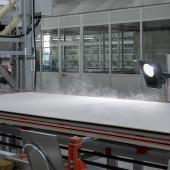China, new prospects for imports
During the Tenth Five-Year Plan, the building materials industry is expected to reach an estimated value of 50.8 billion euro, about 6% of China’s annual GDP.
Some 500 million square metres of new housing is built every year, fuelling a steady increase in expenditure on interior decoration, which according to the latest national statistics has already reached US $80 billion /year, including $37 billion on public buildings, $6 billion on hotel facilities and $43 billion on residential building.
Although domestic production continues to meet almost all demand, imports are showing signs of improvement (1.84 million square metres in 2002). Growing urbanisation, the development of cities with new residential districts and prestigious business centres are fuelling demand for high-quality products which local companies are unable to provide.
For this reason imported tiles is being chosen, principally from Italy and Spain. Private expenditure in this new market segment varies enormously, ranging from $1,200-3,600 for the smallest 50 square metre apartments up to $6,000-12,000 for larger 150 square metre homes.
The potential for a recovery in exports has also been improved by China’s entry into the WTO, one of the first consequences of which has been a substantial reduction in import duty, slashed from 60% to 12% for tiles and from 60% to 10% for sanitaryware.
The in-focus section contains information on the Chinese ceramic industry and export figures for Italian ceramic machinery manufacturers, who have always been the main suppliers of complete plants and individual machines to the Chinese market.
In 2002 ceramic production in China, the world’s largest tile producer and consumer country, totalled 66.5 billion RMB (about 6.8 billion euro), 13.3% up on 2001.
Almost half of this (47%) was generated by the tile industry, followed by tableware (24%), sanitaryware (21%) and technical and artistic ceramic (8%). In 2002 China produced a total of 1,868.5 million square metres of tiles, 485,400 tons of sanitaryware and 16,470 million pieces of ceramic tableware.
To deal with the problem of overproduction, the Chinese government recently decided to close down small units with obsolete technology and production capacity below 700,000 sq.m/year.
In the tile and sanitaryware segments alone there are about 3,500 companies, of which only about a thousand have a turnover higher than 500,000 euro. The difficulty of surveying this industry derives from its high degree of fragmentation, with hundreds of small companies accounting for 54% of all tile production (1 billion sq.m out of a total of 1.86 billion sq.m).
A direct consequence of this is a low quality level, with just 20% of production (374 million square metres) in the high-end segment. However, this percentage is expected to continue to increase steadily as it has done over the past 10 years.
Since 1983 (the year in which the first complete tile plant fabricated in Italy was installed in China), the Italian ceramic machinery manufacturers are estimated to have exported more than 400 complete plants, 420 kilns and 3000 presses to China.
Italy has been far and away the leading supplier of technology, with record sales figures in the first half of the 1990s (in 1993 the value of Italian exports to China totalled 372.3 million euro, equivalent to 38% of all Italian ceramic machinery exports).
Since the second half of the 1990s, exports of Italian technology have fallen to between 85 and 100 million euro/year. This is due to the fact that the enormous production capacity installed in the space of just a few years has had to be absorbed (domestic tile demand is still 40% below production capacity). Chinese demand for advanced Italian technology is no longer oriented towards expansion in terms of quantities but improvement in terms of the quality of production, which is still considerably below western standards.
90% of small and medium-sized Chinese enterprises now have obsolete plant and technologies. The Chinese market accounts for 9-10% of the Italian ceramic machinery industry’s total exports and many Italian companies have long been operating in China with their own production sites or sales branches. These include leading names at a world level such as Sacmi Hong Kong, Barbieri & Tarozzi, Welko Industriale and System.
Did you find this article useful?
Join the CWW community to receive the most important news from the global ceramic industry every two weeks
Recent articles
Florim opens a new Flagship Store in Los Angeles
Jun 13, 2025






















